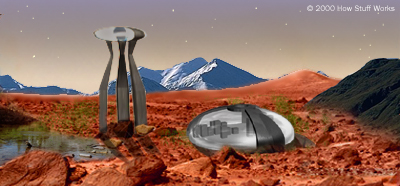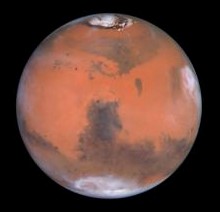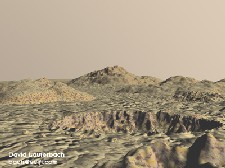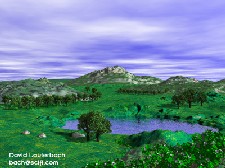|
|
|
November 06, 2000 from HowStuffWorks Website
Introduction
The arrival of these three astronauts at the ISS on Nov. 2, 2000, sparked one NASA official to remark,
An artist's concept of how a Mars colony may look on a terraformed Mars.
As pictures beamed back from planetary probes and rovers since 1964 have shown, Mars is a desolate, lifeless planet with seemingly little to offer humans. It has a very thin atmosphere and no signs of existing life - but Mars does hold some promise for the continuation of the human race.
There
are more than six billion people on Earth, and that number continues
to grow unabated. This overcrowding, or the possibility of planetary
disaster, will force us to eventually consider new homes in our
solar system, and Mars may have more to offer us than the photos of
its barren landscape now show.
With fluvial evidence mounting that water may still exist in a frozen state on Mars, there are many who suggest that the human race could one day make Mars its second home. Such an effort to colonize Mars would begin with altering the current climate and atmosphere to more closely resemble that of Earth's.
The process of transforming the Martian atmosphere to create a more habitable living environment is called terraforming.
In this edition of How
Stuff Will Work, you will find out why Mars is the ideal candidate
for colonization, and how we plan to terraform the red planet for
human habitation.
Photo courtesy NASA
Each story creates its own unique image of what might exists on the red planet. What is it about Mars that makes it the subject of so many tales? While Venus is often referred to as Earth's sister planet, the conditions that exist on that fiery planet are far too uninhabitable. On the other hand, Mars is the next closest planet to us.
And although it is a cold, dry planet today, it holds all of the elements that are needed for life to exist, including:
There are amazing similarities between the Martian atmosphere that exists today and the atmosphere that existed on Earth billions of years ago.
When the Earth was first formed, no oxygen existed on our planet and it, too, looked like a desolate, unlivable planet. The atmosphere was made entirely of carbon dioxide and nitrogen. It wasn't until photosynthetic bacteria developed on Earth that enough oxygen was produced to allow for the development of animals. Similarly, the thin Mars atmosphere today is almost totally composed of carbon dioxide.
Here is the composition of Mars' atmosphere:
In contrast, Earth's atmosphere consists of:
As you can see by this breakdown, any humans visiting Mars today would have to carry with them huge amounts of oxygen and nitrogen in order to survive. However, the similarity to the early Earth and modern Mars atmospheres has led some scientists to speculate the same process that turned the Earth's atmosphere from mostly carbon dioxide into breathable air could be repeated on Mars.
To do so would thicken the atmosphere and
create a greenhouse effect that would heat the planet and provide a
suitable living environment for plants and animals.
However, there are a few Martian features that are close enough to Earth's to consider it for habitation, including:
Other worlds have been considered as possible candidates for terraforming, including Venus, Europa (a Jupiter moon), and Titan (a Saturn moon).
However, Europa and Titan are too far from the sun, and Venus is too close (the average temperature on Venus is about 900° Fahrenheit - 482.22° Celsius). Mars stands alone as the one planet in our solar system, not including Earth, that might be able to support life.
In the next section, learn how scientists plan
to transform the dry, cold landscape of Mars into warm, livable
habitat.
Photo courtesy Lightworld
Terraforming the entire planet into an Earth-like habitat would have to be done over several millennia. Some have even suggested that such a project would last thousands of millennia. So, how are we supposed to transform a dry, desert-like land into a lush environment, where people, plants and other animals can survive.
Here are three terraforming methods that have been proposed:
NASA is currently working on a solar sail propulsion system that would use large reflective mirrors to harness the sun's radiation to propel spacecraft through space.
Another use for these large mirrors would be to place them a couple hundred thousand miles from Mars and use the mirrors to reflect the sun's radiation and heat the Martian surface. Scientists have proposed building mylar mirrors that would have a diameter of 250 km (155.34 miles) and cover an area larger than Lake Michigan. These gigantic mirrors would weigh about 200,000 tons, which means they would be far too large to launch from Earth.
However, there is the possibility that the mirrors could be
constructed from material found in space.
Their sole purpose would be to pump out
CFCs, methane, carbon dioxide and other greenhouse gases into the
atmosphere.
It would take many
years, but the Mars atmosphere would slowly be oxygenated to the
point that Mars colonists would need only a breathing-assistance
apparatus, and not a pressure suit as worn by astronauts.
Photosynthetic bacteria could also be used in place of or in
addition to these greenhouse machines.
The rockets would move the asteroids at about 4 kilometers per second, for a period of about 10 years, before the rockets would shut off and allow the 10-billion-ton asteroids to glide, unpowered, toward Mars. Energy released upon impact would be about 130 million megawatts of power.
That's enough
energy to power Earth for a decade.
Several of these missions over 50
years would create a temperate climate and enough water to cover 25
percent of the planet's surface. However, the bombardment by
asteroids, each releasing energy equivalent to 70,000 one-megaton
hydrogen bombs, would delay human settlement of the planet for
centuries.
To transform the Mars landscape into one that resembles Earth is not a simple project.
It will take many centuries of human ingenuity and labor to develop a habitable environment and bring life to the cold, dry world of Mars.
|





